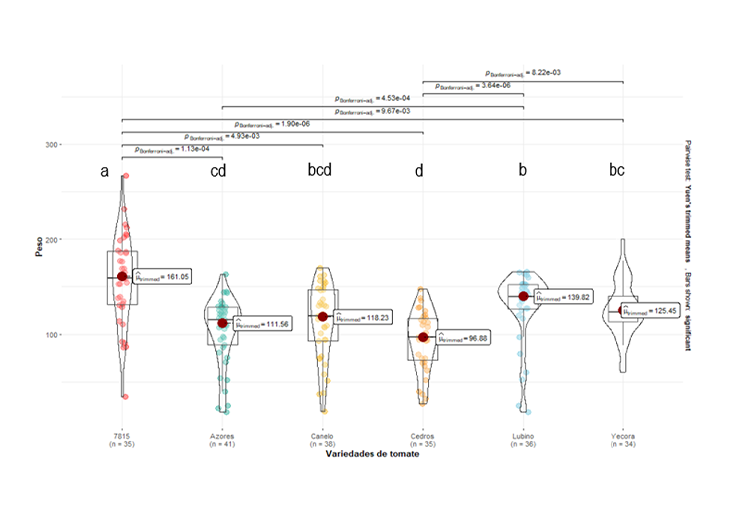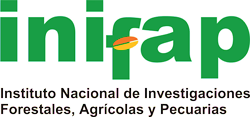Productivity of six varieties of Saladette tomato under greenhouse conditions in Ojocaliente, Zacatecas
DOI:
https://doi.org/10.29312/remexca.v16i30.4051Keywords:
Solanum lycopersicum, fruit quality and quantity, protected agricultureAbstract
Tomatoes are one of the most economically important horticultural crops worldwide, and Mexico stands out as one of the leading producers. Due to their relevance, it is essential to carry out studies that allow us to know the yield of the various varieties and improve decision-making by producers. The study aimed to characterize six varieties of Saladette tomatoes and evaluate their productivity under greenhouse conditions in the municipality of Ojocaliente, Zacatecas, from May to August 2023. Fruit quality and quantity variables, including size (equatorial length and width), fruit weight, and number of harvestable fruits, were measured during the first five fruit cuts. The results showed that variety 7815 presented the highest averages in length (79.43 mm), width (59.04 mm), and weight (158.14 g) of the fruit, followed by the Lubino variety, with 76.67 mm, 54.67 mm, and 129.1 g, respectively. On the other hand, the Cedros variety presented the lowest values in these variables, with 67.08 mm, 49.17 mm, and 93.56 g, respectively. Regarding the number of harvestable fruits, no significant differences were observed between the varieties studied. These results provide valuable information that can help producers in the selection of the most suitable variety according to the desired characteristics of the fruit and the needs of the market.
Downloads
References
Balbuena-Mascada, S.; Lobato-Ortiz, R.; García-Zavala, J. J.; Cruz-Izquierdo, S. y Rodríguez-Guzmán, E. 2023. Comportamiento de líneas de tomate Saladette con hábito de crecimiento determinado en invernadero. Revista Fitotecnia Mexicana. 46(4):367-374. https://doi.org/10.35196/rfm.2023.4.367.
Bugarín-Montoya, R.; Galvis-Spinola, A.; Sánchez-García, P. and García-Paredes, D. 2002. Demanda de potasio del tomate tipo Saladette. Terra Latinoamericana. 20(4):391-399.
Chambers, J. M.; Freeny, A. E. y Heiberger, R. M. 1992. Analysis of variance; designed experiments. In: statistical models in S. Chambers, J. M. and Hastie, T. J. Ed. Wadsworth & Brooks/Cole. New York, USA. 145-193.
Cih-Dzul, I. R.; Jaramillo-Villanueva, J. L.; Tornero-Campante, M. A. y Schwentesius-Rindermann, R. 2011. Caracterización de los sistemas de producción de tomate (Lycopersicum esculentum Mill.) en el estado de Jalisco, México. Tropical and subtropical agroecosystems. 14(2):501-512.
FAOSTAT. 2023. Food and Agriculture Organization Corporate Statistical Database. http://www.fao.org/faostat/es/ #data/QC.
Field, A. P. 2013. Discovering statistics using IBM SPSS Statistics. Sage. 737-738 pp.
Fox, J. D. and Weisberg, H. S. 2019. An {R} companion to applied regression, third Ed. Thousand Oaks CA: Sage. 160 p. https://socialsciences.mcmaster.ca/jfox/Books/Companion/.
García-León, Á.; Robledo-Torres, V.; Mendoza-Villarreal, R.; Ramírez-Godina, F.; Valdez-Aguilar, L. A. y Gordillo-Melgoza, F. A. 2018. Producción de variedades tradicionales de tomate con acolchado en invernadero. Ecosistemas y Recursos Agropecuarios. 5(14):303-308. https://doi.org/10.19136/era.a5n14.1439.
González, B. M.; Fortis, H. M.; Preciado, R. P.; Segura, C. M.; Salazar, S. E.; García, H. J.; y Esparza, R. J. 2016. Calidad fitoquímica de tomate Saladette producido con sustratos orgánicos bajo condiciones de invernadero. Phyton. 85(1):71-78.
Gross, H. J. and Ligges, U. 2015. -nortest: tests for normality-. R package version 1.0-4. https://CRAN.R-project.org/package=nortest>. 1-19 pp.
Luna-Fletes, J. A.; Can-Chulim, Á.; Cruz-Crespo, E.; Bugarín-Montoya, R. y Valdivia-Reynoso, M. G. 2018. Intensidad de raleo y soluciones nutritivas en la calidad de tomate cherry. Revista Fitotecnia Mexicana. 41(1):59-66. https://doi.org/10.35196/rfm.2018.1.59-66.
Maldonado-Peralta, M. Á.; Salinas-Vargas, D.; Rojas-García, A. R.; Hernández-Bautista, A.; Álvarez-Vázquez, P. y Maldonado-Peralta, R. 2023. Comportamiento agronómico de poblaciones mexicanas de tomate (Solanum lycopersicum L.) nativo bajo dos sistemas de producción. Revista Bio Ciencias. 10(1):1-16. https://doi.org/10.15741/revbio.10.e1413.
Maldonado-Peralta, R.; Ramírez-Vallejo, P.; González-Hernández, V. A.; Castillo-González, F.; Sandoval-Villa, M.; Livera-Muñoz, M. y Cruz-Huerta, N. 2016. Riqueza agronómica en colectas mexicanas de tomates (Solanum lycopersicum L.) nativos. Agroproductividad. 9(12):68-75.
Mejía-Betancourt, F.; Sanchez-Castillo, F.; Moreno-Pérez, E.; y González-Molina, L. 2023. Esquejes enraizados, una alternativa para la producción de jitomate bajo invernadero en ciclos cortos. Revista Mexicana de Ciencias Agrícolas. 14(3):389-399. https://doi.org/10.29312/remexca.v14i3.3038.
Monge-Pérez, J. E. 2014. Caracterización de 14 genotipos de tomate (Lycopersicon esculentum Mill.) cultivados bajo invernadero en Costa Rica. Tecnología en marcha. 27(4):58-68. https://doi.org/10.18845/tm.v27i4.2086.
Montaño-Méndez, I. E.; Valenzuela-Patrón, I. N. y Villavicencio López, K. V. 2021. Competitividad del tomate rojo de México en el mercado internacional: análisis 2003-2017. Revista Mexicana de Ciencias Agrícolas. 12(7):1185-1197. https://doi.org/10.29312/remexca.v12i7.2531.
Padilla-Bernal, L. E.; Rumayor-Rodríguez, A. F. y Pérez-Veyna, O. 2008. La competitividad sistémica de la industria del tomate de agricultura protegida en Zacatecas. Mercados y Negocios. 18(1):38-59. https://doi.org/10.32870/myn.v0i18.5094.
Patil, I. 2021. Visualizations with statistical details: the ‘ggstatsplot’ approach. Journal of Open Source Software. 61(1):1-15. https://doi.org/10.21105/joss.03167.
R Core Team. 2022. R: a language and environment for statistical computing. R Foundation for Statistical Computing, Vienna, Austria. URL https://www.R-project.org/.
Rivas, M. P.; Albarracín, M.; Moratinos, H. y Navas, F. Z. 2012. Rendimiento y calidad de fruto en cuatro cultivares de tomate (Solanum lycopersicum L.) bajo condiciones protegidas. Revista Facultad de Agronomía. 29(3):395-412.
Rodríguez-Burgos, A.; Yala-Garay, O. J.; Livera-Hernández, A.; Leal-León, V. M. y Cortez-Mondaca, E. 2011. Desarrollo de fruto y semilla de cinco variedades de tomate de cáscara en Sinaloa. Revista Mexicana de Ciencias Agrícolas. 2(5):673-687. https://doi.org/10.29312/remexca.v2i5.1617.
Sánchez-Castillo, F.; Moreno-Pérez. E. C.; Pastor-Zarandona, O. A. y Contreras-Magaña, E. 2017. Disposición de plantas de tomate en doseles en forma de escalera bajo dos densidades de población. Revista Fitotecnia Mexicana. 40(3):333-340. Doi: 10.35196/rfm.2017.3.333-340.
Santiago, J.; Mendoza, M. y Borrego, F. 1998. Evaluación agronómica de tomate (Lycopersicon esculentum M.) en invernadero: criterios fenológicos y fisiológicos. Agronomía Mesoamericana. 9(1):59-65. https://doi.org/10.15517/am.v12i1.17246.
Wilcox, R. R. 2022. Introduction to robust estimation and hypothesis testing Fifth Ed. Elsevier. California, USA. 397-398 pp.
Yuen, K. K. 1974. The two-sample trimmed t for unequal population variances. Biometrika. 61(1):165-170. https://doi.org/10.2307/2334299.

Published
How to Cite
Issue
Section
License
Copyright (c) 2025 Revista Mexicana de Ciencias Agrícolas

This work is licensed under a Creative Commons Attribution-NonCommercial 4.0 International License.
The authors who publish in Revista Mexicana de Ciencias Agrícolas accept the following conditions:
In accordance with copyright laws, Revista Mexicana de Ciencias Agrícolas recognizes and respects the authors’ moral right and ownership of property rights which will be transferred to the journal for dissemination in open access. Invariably, all the authors have to sign a letter of transfer of property rights and of originality of the article to Instituto Nacional de Investigaciones Forestales, Agrícolas y Pecuarias (INIFAP) [National Institute of Forestry, Agricultural and Livestock Research]. The author(s) must pay a fee for the reception of articles before proceeding to editorial review.
All the texts published by Revista Mexicana de Ciencias Agrícolas —with no exception— are distributed under a Creative Commons License Attribution-NonCommercial 4.0 International (CC BY-NC 4.0), which allows third parties to use the publication as long as the work’s authorship and its first publication in this journal are mentioned.
The author(s) can enter into independent and additional contractual agreements for the nonexclusive distribution of the version of the article published in Revista Mexicana de Ciencias Agrícolas (for example include it into an institutional repository or publish it in a book) as long as it is clearly and explicitly indicated that the work was published for the first time in Revista Mexicana de Ciencias Agrícolas.
For all the above, the authors shall send the Letter-transfer of Property Rights for the first publication duly filled in and signed by the author(s). This form must be sent as a PDF file to: revista_atm@yahoo.com.mx; cienciasagricola@inifap.gob.mx; remexca2017@gmail.
This work is licensed under a Creative Commons Attribution-Noncommercial 4.0 International license.


